The Dorado Constellation is home to two stars with known planets and one formally named star. Its name, as approved by the International Astronomical Union (IAU), is Naledi (WASP-62). The brightest star in the constellation is Alpha Doradus.
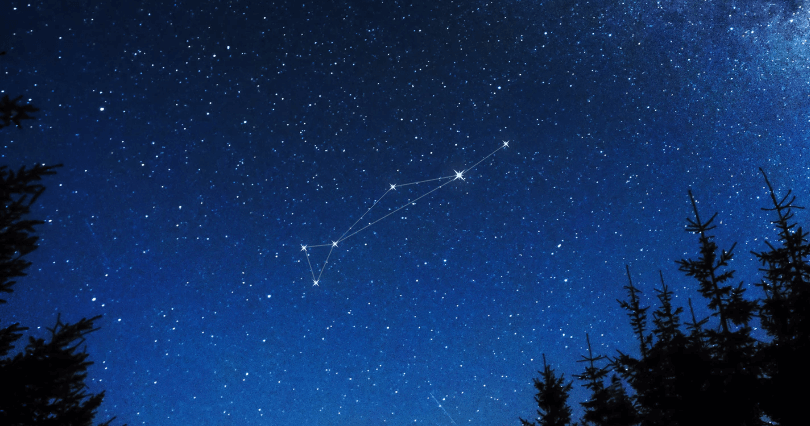
There are no Messier objects in the constellation and no known meteor showers associated with it. However, it is home to some interesting deep sky objects, such as the Tarantula Nebula, the Large Magellanic Cloud and the Ghost Head Nebula.
History and Mythology Of The Dorado Constellation
There are no myths associated with the constellation of Dorado. It was created by the Dutch astronomer Petrus Plancius from the observations of Dutch navigators Pieter Dirkszoon Keyser and Frederick de Houtman. He mostly named the newly created constellations after animals, which is why Dorado translates to “the dolphinfish” in Spanish. It has also sometimes been known as the Swordfish constellation. The Dorado constellation was known in the 17th and 18th century as Xiphias.
Location Of The Dorado Constellation
The constellation of Dorado is the 72nd largest constellation in the night sky and occupies an area of 179 square degrees. It is located in the first quadrant of the southern hemisphere (SQ1) and can be seen at latitudes between +20° and -90°.
Its right ascension is 5h and its declination is −65°. It is best seen at 9pm during the month of January. The South Ecliptic pole also lies within this constellation.
Dorado’s neighboring constellations are Caelum, Horologium, Hydrus, Mensa, Pictor, Reticulum and Volans and it belongs to the Johann Bayer family of constellations, along with Apus, Chamaeleon, Grus, Hydrus, Indus, Musca, Pavo, Phoenix, Tucana and Volans.
Notable Stars
Alpha Doradus
Alpha Doradus is the brightest star in the constellation and its magnitude ranges from 3.26 to 3.30. It is one of the brightest binary stars known, composed of a giant belonging to the spectral class A0III, and a subgiant of the spectral type B9IV. The system is located around 169 light years away.
The primary is a Si star, which means that its atmosphere exhibits an exceptionally high abundance of silicon, and it has a visual magnitude of 3.8. The companion has a magnitude of 4.3. There is an optical companion 77 arc seconds away, but it is not physically associated with the main pair.
Beta Doradus
Beta Doradus is the second brightest star in the constellation and has a magnitude that varies from 4.05 to 3.45. It is a Cepheid variable star with a spectral type that varies from F-type to G-type. It is located around 1,050 light years away from Earth.
Delta Doradus
Delta Doradus has an apparent magnitude of 4.34 and belongs to the spectral type A7V. It is located around 145 light years away from us and is notable for being the Moon’s South Pole star.
Gamma Doradus
Gamma Doradus has a visual magnitude of 4.25 and is located around 66.2 light years away from us. It is a variable star that serves as a prototype of stars known as the Gamma Doradus variables. These stars are pulsating variables whose brightness varies by less than a tenth of a magnitude as a result of non-radial gravity wave oscillations.
Zeta Doradus
Zeta Doradus is a yellow-white main sequence star of the spectral type F7 V and has a visual magnitude of 4.68. It is located around 38 light years away from Earth and will move into the constellation Pictor around the year 6400.
R Doradus
R Doradus, also known as HD 29712, is a red giant star belonging to the spectral class M8 III with a mean visual magnitude of 5.40. Its brightness fluctuates between 4.8 and 6.6 magnitudes and it is classified as a Mira variable.
It has a diameter that is 370 times that of the Sun and is believed to be the star with the second largest apparent size when observed from Earth, second only to the Sun. It is located around 178 light years away from us.
S Doradus
S Doradus is a hypergiant with a mean visual magnitude of 9.565, as its brightness varies from 8.6 to 11.5 magnitudes. It serves as a prototype for a group of variable stars known as the S Doradus variables. It is a luminous blue variable that exhibits changes in brightness over long periods of time, with occasional outbursts. S Doradus is usually classified as spectral type A0e, but in fact has the spectrum of a F0 class star.
S Doradus is one of the most luminous stars known and one of the brightest stars in the Large Magellanic Cloud, yet it cannot be seen by the naked eye because it is located around 169,000 light years away.
HE 0437-5439
HE 0437-5439 is an unbound hypervelocity star that is a main sequence star of the spectral type BV. It was first discovered in 2005 by observers at the European Southern Observatory and is believed to be about 30 million years old. It appears to be receding from us at the speed of 723 kilometres per second, and, because it is moving at such a high velocity, the star is no longer gravitationally bound to the Milky Way and will eventually leave the galaxy and move into intergalactic space.
Currently, it is located around 200,000 light years away from us. It has a visual magnitude of 6.3 and a mass nine times that of the Sun.
Deep Sky Objects
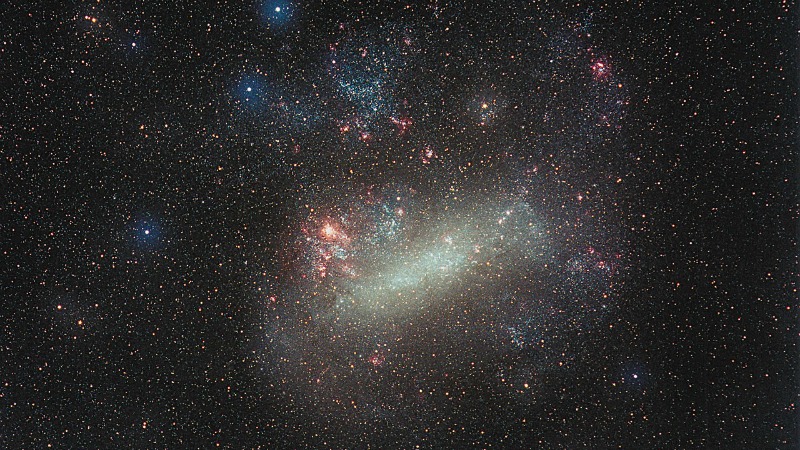
Large Magellanic Cloud
The Large Magellanic Cloud, also known as LMC, is an irregular galaxy that is located around 157,000 light years away from us in the constellations Dorado and Mensa. It is a satellite galaxy to the Milky Way, and the third closest galaxy to ours, but is only 1/100 as massive as the Milky Way, with ten billion times the mass of the Sun and a radius of about 14,000 light years.
LMC contains about 700 open clusters, 400 planetary nebulae and 60 globular star clusters, as well as many supergiant and giant stars. It has a visual magnitude of 0.9 and is the fourth largest galaxy in the Local Group. It has an interesting shape, which is believed to be a result of tidal interactions with the Milky Way and the Small Magellanic Cloud. The LMC is also rich in gas and dust, and currently undergoing intense star forming activity.
The Large Magellanic Cloud was first mentioned by the Persian astronomer Abd al-Rahman al-Sufi in 964 AD in his Book of Fixed Stars, but it was Ferdinand Magellan who introduced the LMC to Europeans, and the galaxy has subsequently been named after him.
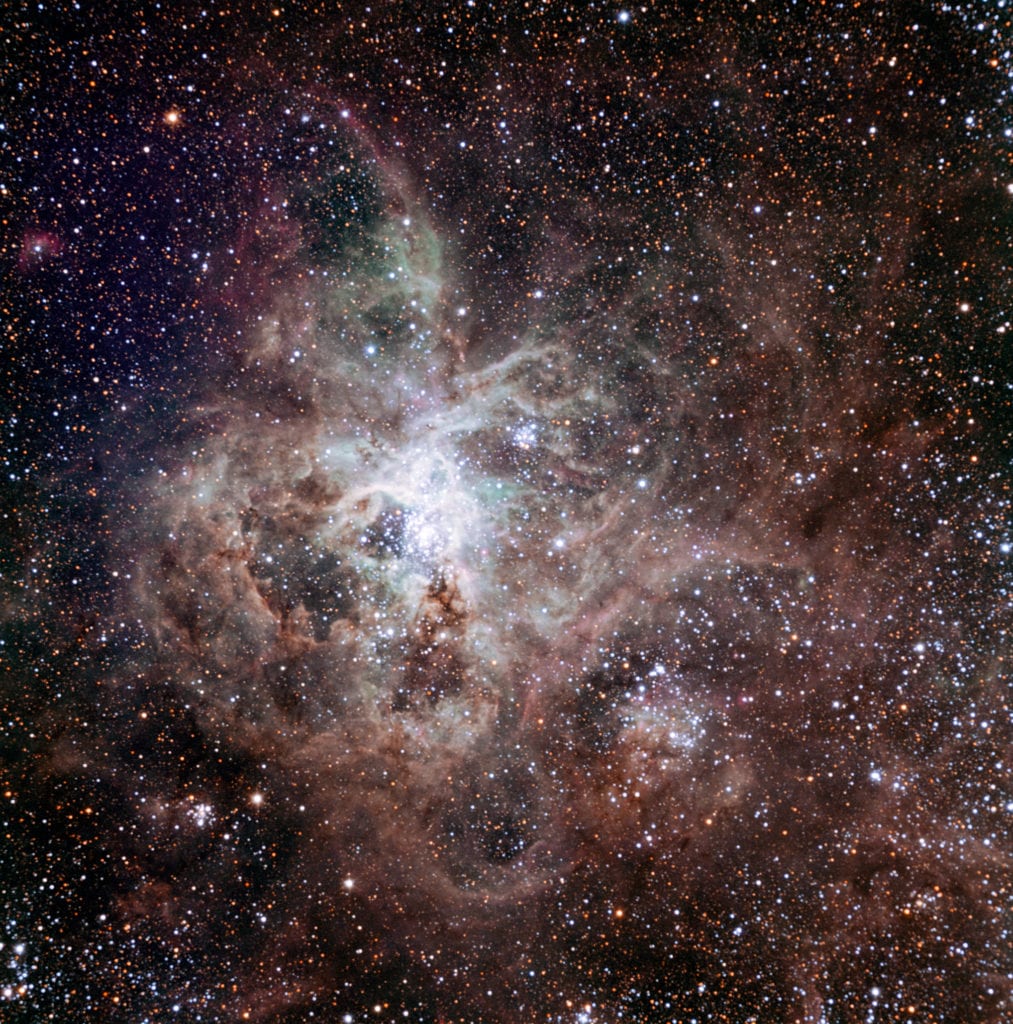
Tarantula Nebula
The Tarantula Nebula, also known as NGC 2070 or 30 Doradus, is an H II region that is located in the Large Magellanic Cloud. It is around 160,000 light years away from us and is the largest and most active star forming region in the Local Group of galaxies, around 500 light years in radius. It has an apparent magnitude of 8 and an absolute magnitude of -11.7.
The Tarantula Nebula was originally believed to be a star but was confirmed to be a nebula by the French astronomer Nicolas Louis de Lacaille in 1751. It is an exceptionally luminous non-stellar object and contains the compact star cluster R136 at its centre. The cluster is responsible for producing most of the energy that makes the nebula so luminous.
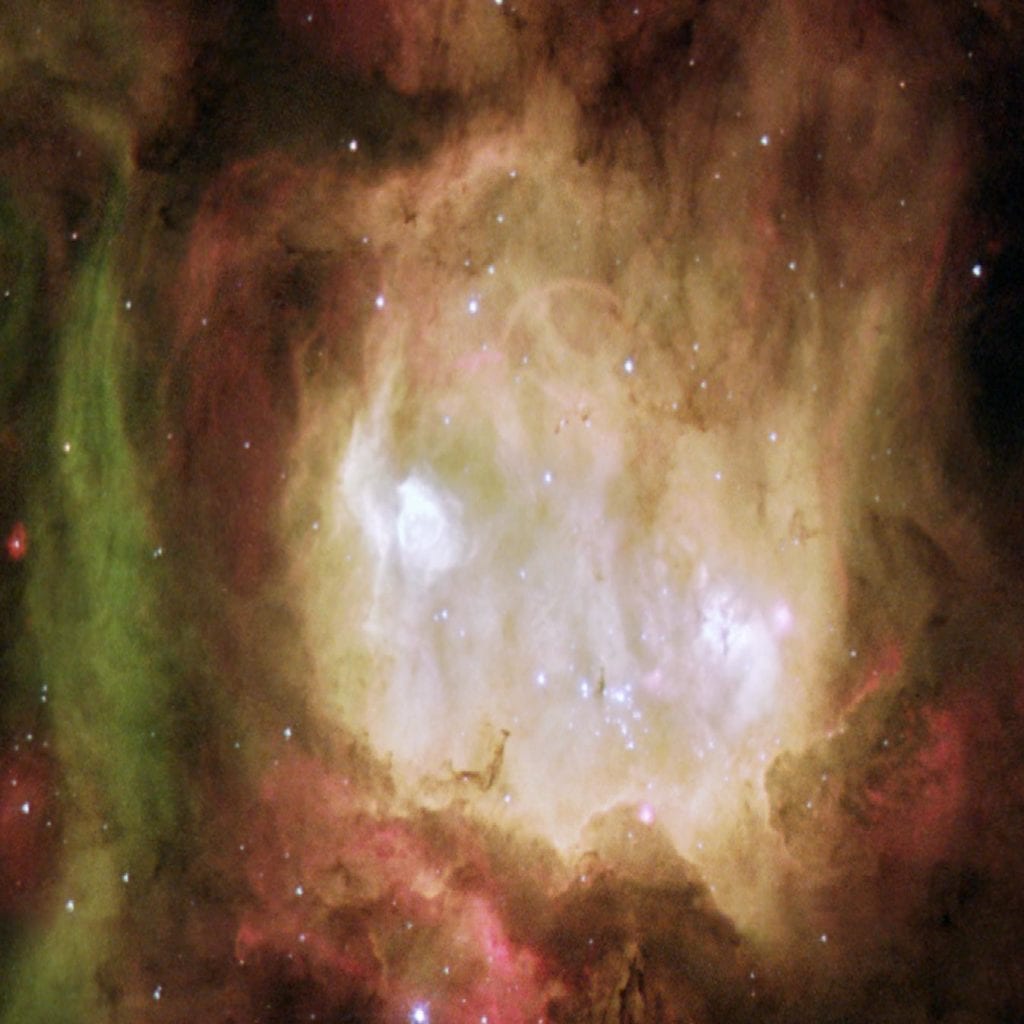
The Ghost Head Nebula
The Ghost Head Nebula, also known as NGC 2080, is a star forming region located in the Large Magellanic Cloud. It is located around 160,000 light years away from us, to the south of the Tarantula Nebula. It was first discovered by John Frederick William Herschel in 1834 and got its name because it has two very distinct white patches called “the eyes of the ghost”.
The Ghost Head Nebula spans 50 light years in diameter. The left of the nebula has been designated A1 and has a bubble at its core created by a young, massive star at the center. The right of the nebula, designated A2, contains a newly formed cluster of young stars.
SNR 0509-67.5
SNR 0509-67.5 is a supernova remnant that is located in the Large Magellanic Cloud. The supernova is thought to have occurred around 400 years ago and it was most likely a type 1a supernova. SNR 0509-67.5 is located around 160,000 light years away.
SN 1987A
SN 1987A was a supernova that occurred in the outer region of the Tarantula Nebula. Its peak magnitude was 2.9, so it could be seen by the naked eye, and the light from the explosion reached Earth on February 23, 1987.
The supernova happened around 167,885 light years from Earth and it was discovered to be a blue supergiant that was the progenitor star.
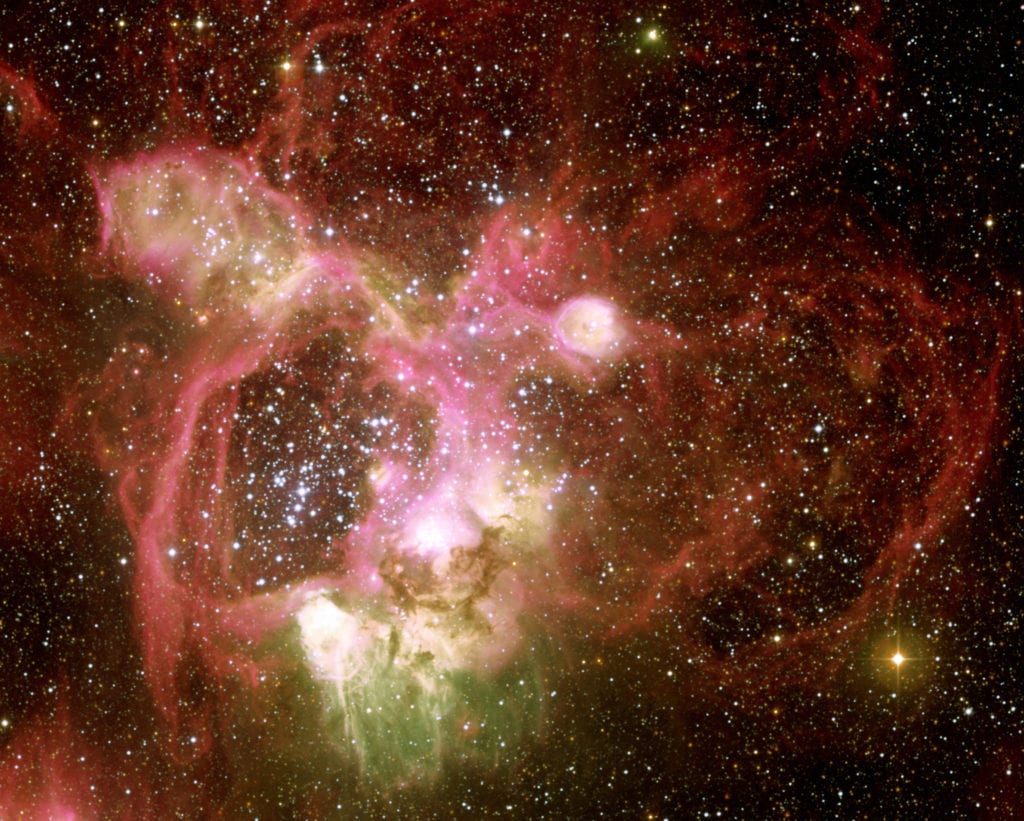
N44
N44 is an emission nebula with a superbubble structure, formed by the radiation pressure of a group of about 40 luminous blue-white stars located near the nebula’s center. The nebula is located around 160,000-170,000 light years away from Earth, in the Large Magellanic Cloud, and is about a thousand light years wide.
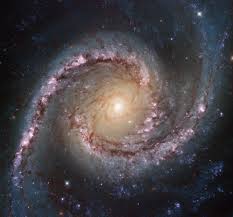
NGC 1566
NGC 1566 is an intermediate spiral galaxy and the brightest galaxy of the Dorado Group with a visual magnitude of 10.3. It is also the second brightest Seyfert galaxy. It is located around 38.4 million light years away from us.
In June 2010, a supernova was observed in NGC 1566.
NGC 1850
NGC 1850 is an open star cluster that was discovered by James Dunlop in 1826. It is unlike any known star cluster in our galaxy, due to the fact its stars are distributed as they would normally be in a globular cluster, yet NGC 1850 contains young stars. Usually, globular clusters in the Milky Way are formed of old stars. The cluster has a visual magnitude of 9.0.
Extra Facts
- Dorado appeared in Johannes Kepler’s edition of Tycho Brahe’s star list in the Rudolphine Tables of 1627. This was the first time that it was named Xiphias, the swordfish.
- On Plancius’s maps of 1592 and 1594, Dorado figured as an elderly bearded man named Polophylax.
- In Chinese astronomy, the stars of Dorado are in two of Xu Guangqi’s Southern Asterisms: the White Patches Attached and the Goldfish.
Images:
- Some Images created with the NightVision app – https://www.nvastro.com/nvj.html
- Some Images created with the Stelvision Sky Map https://www.stelvision.com/en/sky-map/
- Dorado 1 – https://starregistration.net/constellations/dorado-constellation.html
- Large Magellanic Cloud – https://earthsky.org/clusters-nebulae-galaxies/the-large-magellanic-cloud
- Tarantula Nebula – https://en.wikipedia.org/wiki/Tarantula_Nebula
- Ghost Head Nebula – https://www.nasa.gov/multimedia/imagegallery/image_feature_967.html
- NGC 1566 – https://en.wikipedia.org/wiki/NGC_1566
- N44 – https://en.wikipedia.org/wiki/N44_(emission_nebula)